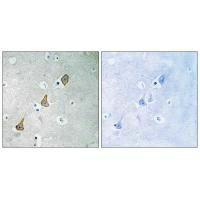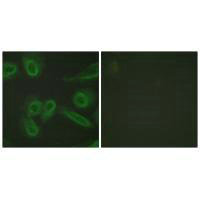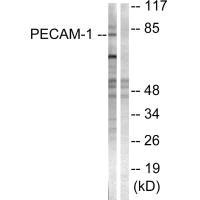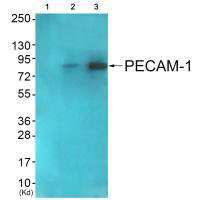
Immunohistochemistry analysis of paraffin-embedded human brain tissue using PECAM-1 (Ab-713) antibody.
PECAM1 (Ab-713) Antibody
CSB-PA116016
ApplicationsImmunoFluorescence, Western Blot, ELISA, ImmunoHistoChemistry
Product group Antibodies
ReactivityHuman, Mouse
TargetPECAM1
Overview
- SupplierCusabio
- Product NamePECAM1 (Ab-713) Antibody
- Delivery Days Customer20
- ApplicationsImmunoFluorescence, Western Blot, ELISA, ImmunoHistoChemistry
- CertificationResearch Use Only
- ClonalityPolyclonal
- ConjugateUnconjugated
- Gene ID5175
- Target namePECAM1
- Target descriptionplatelet and endothelial cell adhesion molecule 1
- Target synonymsCD31; CD31 antigen; CD31/EndoCAM; endoCAM; GPIIA'; PECA1; PECAM-1; platelet endothelial cell adhesion molecule; platelet endothelial cell adhesion molecule-1
- HostRabbit
- IsotypeIgG
- Protein IDP16284
- Protein NamePlatelet endothelial cell adhesion molecule
- Scientific DescriptionInduces susceptibility to atherosclerosis By similarity. Cell adhesion molecule which is required for leukocyte transendothelial migration (TEM) under most inflammatory conditions. Tyr-690 plays a critical role in TEM and is required for efficient trafficking of PECAM1 to and from the lateral border recycling compartment (LBRC) and is also essential for the LBRC membrane to be targeted around migrating leukocytes. Prevents phagocyte ingestion of closely apposed viable cells by transmitting detachment signals, and changes function on apoptosis, promoting tethering of dying cells to phagocytes (the encounter of a viable cell with a phagocyte via the homophilic interaction of PECAM1 on both cell surfaces leads to the viable cells active repulsion from the phagocyte. During apoptosis, the inside-out signaling of PECAM1 is somehow disabled so that the apoptotic cell does not actively reject the phagocyte anymore. The lack of this repulsion signal together with the interaction of the eat-me signals and their respective receptors causes the attachment of the apoptotic cell to the phagocyte, thus triggering the process of engulfment). Isoform Delta15 is unable to protect against apoptosis. Modulates BDKRB2 activation. Regulates bradykinin- and hyperosmotic shock-induced ERK1/2 activation in human umbilical cord vein cells (HUVEC). Tieming Zhao, J. Cell Biol., Jan 2001; 152: 65. SM Watt, Blood, Nov 1993; 82: 2649 - 2663. NETA ILAN, FASEB J, Feb 2001; 15: 362.
- ReactivityHuman, Mouse
- Storage Instruction-20°C or -80°C
- UNSPSC12352203



